
Gamification is becoming more common
Gamification has existed for a long time. We’re all familiar with air miles programs, such as American Airline’s AAdvantage, and free giveaways, such as McDonald’s Happy Meal Toys – both of which reward us for interacting with a brand. But as technology evolves, digital rewards, like Candy Crush’s daily treat machine, offer new ways for brands to encourage increasingly repeated interaction.
We now also have access to data that can personalize a fan’s experience to make that engagement even more gratifying. And, more importantly from a business perspective, we can collect this data in a natural and authentic way. When it comes to sports, traditional game mechanics like reward points, leaderboard rankings, or badges are now complemented by live, interactive elements such as quizzes, polls, prediction questions, and in-app messaging.
The recent proliferation of fantasy sports and sports betting in the United States has helped fans to feel more comfortable with gamification. “Now, you’re no longer just following your favorite team or the players you’re affiliated with,” said Michelene. “You’ve got your whole fantasy squad, week by week or game by game, that you’re invested in.”
Gamification is also bridging the gap between physical and digital experiences. At live sporting events, jumbotron games and halftime shows keep fans engaged during timeout periods or “dips” in the action. Previously, fans watching from home would miss out – but brands are now introducing equally powerful opportunities for remote interaction. Vishal highlighted France TV’s viewer engagement through the Summer Olympics: “They integrated gamification features like live chat and quizzes and saw over a million users register to participate.”
These simple additions not only boost fan interactions, but also help brands gain first-party data, convert anonymous viewers into known users, and build up long-term audience relationships. As Joshua said, “The point of gamification is not just to engage the fans, but also to collect meaningful data. Brands always want to know more about their audience and the more fun and authentic this process feels, the better the outcomes.”
Personalization is everything
This element of fun is crucial for successful gamification. To get users to behave in ways that benefit you, you need to create experiences that feel genuine and encourage excitement around fans’ favorite teams and players. However, achieving this personalization at scale is tough – so it’s important to lean into both your data and the latest technologies.
“Gen AI allows you to prompt in a topic, team, or player theme and publish 20 quiz questions or polls to keep your viewers engaged,” said Vishal. “It lowers resourcing barriers, removing the need for a moderator to come up with questions on the fly. AI sentiment analysis can also help to moderate unflattering or inappropriate content, ensuring gamification remains a positive experience for both fans and brands.”
The panel also discussed how brands can draw fan conversations away from external sites like WhatsApp or Discord and onto owned, operated chat platforms. “You need to tap into fans’ innate desires to talk, engage in debate, and vote for who they want to see traded,” Joshua added. “These conversations are already happening elsewhere on fan sites and social media, so it’s important to bring them into your own experience so that they feel part of the team.”
Data is invaluable - but it must be collected correctly
Seeing how your users engage with your applications will provide useful data to support other revenue streams. Examining the specific behavior of season ticket holders can lead to interesting insights into churn propensity, for instance. And it begins from a user’s first interaction – you can replace standard registration flows by capturing user preferences via organic polls and quizzes and creating anonymized user IDs for personalization.
Gamification data can also create invaluable opportunities for cross-promotion. Take this hypothetical example from Vishal: “Golf broadcasters could display a poll that asks viewers which Titleist driver they’d use on a particular hole. It’d help Titleist bring awareness to their products, but also capture data from users on what they’d prefer. You can then sell that data back to Titleist, or help Titleist target users for personalized e-commerce flow.”
However, lots of states are implementing laws, similar to CCPA in California, that impact the ways brands can collect data. This makes data governance – the correct management of data access, collection, and storage – even more important.
KPIs should come before strategy
Alongside proper data governance comes another key preliminary step. Gamification strategies are great – but first, it’s important to figure out what you’re trying to accomplish. On top of core engagement metrics such as time spent, return frequency, and session length, goals like increasing transactions or reducing churn might require more specific strategies.
As Joshua said, “If half of your audience is made up of casual fans, how do you employ a gamification strategy that converts them into a deeply engaged fan? Pairing multiple gamification strategies with data analysis can help you take a more individualized approach.”
“It’s also important to constantly measure performance on a granular level,” Michelene added. “Collecting enough data to highlight where strategies are and aren’t working helps you engage with fans in the most effective ways.”
Successful gamification requires flexible infrastructure
Ultimately, sports fans’ customer journeys are fragmented. Viewing, betting, merchandising, and fan discussions happen on different platforms. No single entity in the sports ecosystem has all the information about a sports fan’s behavior, and so partnerships are massively important to getting a fuller picture.
To make those partnerships useful, organizations need a data infrastructure that is comprehensive enough to take in all of that information and provide the best possible insights. Flexible infrastructure can also allow you to incorporate new partners as platforms develop and viewing behaviors evolve.
“You need a holistic data stack – a system design that’s easy to plug in and out of and pushes downstream and upstream, so you can turn it into actionable insights,” Joshua said. “Ask yourself: have you architected your data in a way that makes sense, connects, and links events back to users? The key to successful gamification is personalization that feels meaningful, genuine, and like it’s from somebody who’s also a fan.”
It’s clear, then, that gamification can help you deepen fan engagement and gather meaningful data. And by combining game mechanics with emerging technologies, you can bridge the physical and digital for outstanding fan experiences at every touchpoint. The success of your gamification, however, relies on clear objectives, robust data governance, and an infrastructure that can adapt to evolving platforms and partnerships. Only by putting watertight strategies in place can you create authentic, enjoyable experiences that both engage fans and provide valuable insights for long-term growth.
Ready for more in-depth insights on the power of gamification? Watch the full webinar session, Transforming Fan Engagement: Gamification Strategies and Success Stories, for free here.
